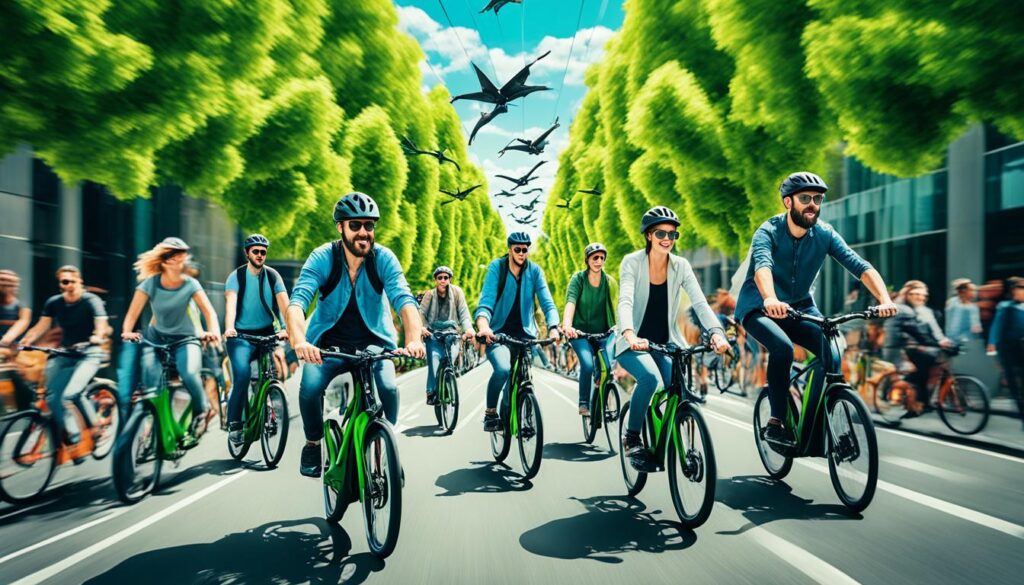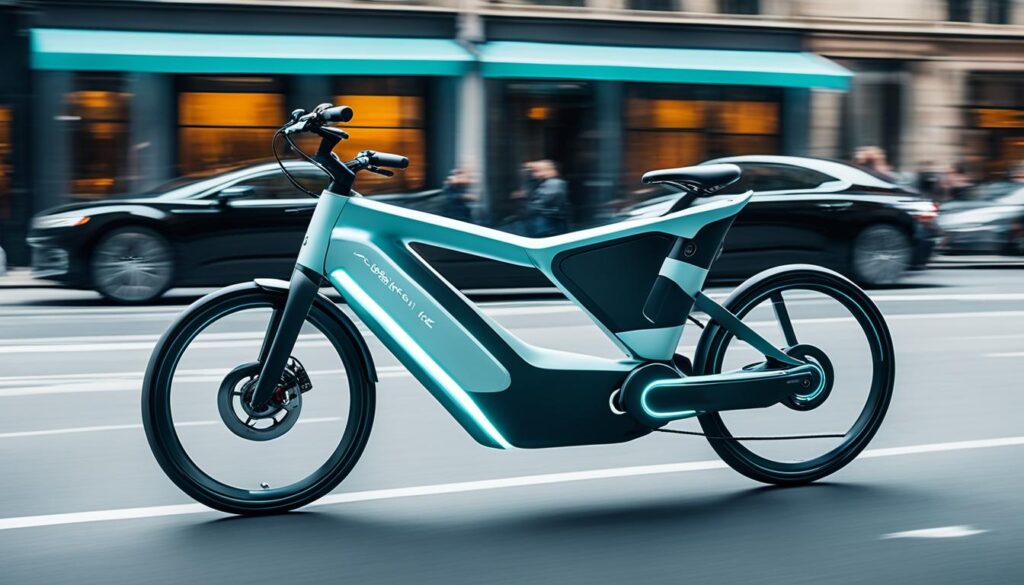Electric bikes, or e-bikes, give you more ways to move around. You can enjoy a calm ride without pedaling in throttle mode. Or, you might want a bit more action with a pedal-assist bike. E-bikes serve different tastes. You can pedal them like regular bikes, or use the Pedal Assist System (PAS) for a boost. This system works when you pedal, adding extra power. Schwinn e-bikes, for example, need you to pedal and set a PAS level for that boost. This follows UK laws requiring pedal power for e-bikes to work. So, it’s up to you if you want to pedal or just cruise along.
Key Takeaways
- E-bikes in the UK cannot exceed 15.5mph with pedal assist to comply with traffic regulations.
- Electric bike batteries typically need a full charge time ranging from five to eight hours, allowing for extended ride periods between charges.
- Durability is paramount, with most e-bike batteries lasting up to 1,000 charges and hub motors capable of reaching nearly 10,000 miles.
- Diverse motor options from respectable brands like Bosch and Suntour allow for a tailored e-biking experience with varied power outputs from 250w to 625w.
- The implementation of cadence and torque sensors in the PAS enhances the ride’s responsiveness and ease.
- E-bike components such as batteries and PAS are designed for both convenience and adaptability, offering up to seven levels of assistance and the freedom to charge on or off the bike.
Understanding Electric Bike Mechanics
An electric bike, or e-bike, mixes classic bike design with modern electrical parts. These parts include a motor, battery, and sometimes a throttle. Riders worldwide are fascinated by e-bikes. They offer a green and efficient way to travel in cities and suburbs. To really get how these bikes work, we need to explore their operation and the types of motor activation: throttle and pedal-assist.
The Basics of E-Bike Operation
E-bikes boost your ride by adding power with an electric motor. This makes pedaling easier, especially when climbing hills. They typically go as fast as 16 to 20 mph, but some top 28 mph. Motor power is regulated to keep speeds safe.
The e-bike’s range depends on its battery. A full charge takes about eight hours and lasts 25 to 30 miles.
Differentiating Between Throttle and Pedal-Assist
E-bikes mainly use two systems for motor power: throttle control and pedal-assist. Throttle control lets you power the bike without pedaling, like a scooter. On the other hand, pedal-assist needs you to pedal to work. It adds power to your pedaling.
Brands like Bluejay offer different levels of pedal assist. This lets riders choose how much help they want, based on the terrain or their preference.
| Feature | Throttle-Controlled E-Bikes | Pedal-Assist E-Bikes |
|---|---|---|
| Motor activation method | Throttle mechanism | Pedaling motion |
| Effort from rider | Minimal to none | Varies based on assist level |
| Speed regulation | By throttle position | By pedaling cadence and chosen assist level |
| Battery usage | Higher consumption, may reduce range | Efficient usage for extended range |
| Typical applications | Short trips and quick acceleration | Long rides, commutes, and fitness |
Choosing between throttle and pedal-assist e-bikes depends on your lifestyle and biking goals. In Europe, strict rules mean pedal-assist e-bikes are common. They’re treated like regular bikes. Throttle e-bikes, or S-Pedelecs, are seen as mopeds or motorcycles. This means more rules to follow.
E-bikes are changing how we move around. By 2007, about 10 to 20 percent of all city bikes in China were e-bikes. In the US, companies like EV Global Motors led the e-bike trend. Understanding how e-bikes work, including the motor systems, makes the experience better. It helps you choose the right e-bike for you and follow local laws.
The Class System of Electric Bikes in the U.S.
The cycling scene in the U.S. now includes electric bikes, leading to a special electric bike class system. This system helps everyone know the difference between bikes by looking at their power and max speed. It makes it easier to know where these bikes can go, whether on streets or trails.
The system looks at motor power, if the bike can go on its own, and how fast it can go. All e-bikes can’t have motors stronger than 750 watts and need working pedals. The use of the throttle changes across different classes. This changes if e-bikes are seen as bikes or motor vehicles. E-bikes mainly using throttles don’t count as regular bicycles.
| E-Bike Class | Operation Mechanism | Max Speed (Assistance Cutoff) | Speedometer Requirement |
|---|---|---|---|
| Class 1 | Pedal-Assisted Only | 20 mph | No |
| Class 2 | Pedal-Assisted or Throttle-Controlled | 20 mph | No |
| Class 3 | Pedal-Assisted | 28 mph | Yes |
Because of Order No. 3376, groups like the Fish and Wildlife Service and the National Park Service play a big role in how e-bikes are used on trails. They worked to offer clear rules in a month. The rule about speedometers for Class 3 e-bikes came from their hard work.
Since December 2, 2020, there’s a new rule for e-bikes in national parks. E-bikes help more people enjoy nature, even those who find moving around tough. But, e-bike riders must follow state rules and know which trails and roads allow their e-bike class.
With these clear classes, people can pick the right e-bike for them. Maybe it’s a Class 1 for fun rides, a Class 2 that’s easy to use, or a quick Class 3 for longer trips. This system makes sure e-bikes are used safely and legally all over the country’s various landscapes.
Exploring Types of Electric Bikes
With 11% of Americans having tried an electric bike in the past year, interest is soaring. You might want an electric commuter bike for city trips or an electric mountain bike for off-road adventures. It’s key to know the different electric bike types before you buy.
Electric Commuter Bikes
Electric commuter bikes are a hit for city travel. They offer features like fenders, lights, and racks, which are great for the 77% who normally drive. Yet, these e-bikes cost more than regular bikes. Trying one out ensures it meets your needs before you commit to buying.
Electric Mountain Bikes versus Pedal-Assist Bikes
Electric mountain bikes offer variety, with pedal-assist and throttle options. For rugged paths, a pedal-assist bike helps by boosting your pedaling power. Checking e-bike ratings for range, power, and hill-climbing abilities is wise to find a good fit for adventures.
In some states, you might need a license or helmet for these bikes. Yet, many choose pedal-assist bikes for the health perks and mental wellness. They promote an active lifestyle, making them a popular option.
Maximizing the Benefits of Riding an Electric Bike
Riding electric bikes offers many advantages, including ease of commuting and health benefits. Using different assistance levels adjusts how much effort you need to put in. It helps tailor your ride to match fitness or leisure aims.
Choosing the Right Assistance Level for Your Ride
Choosing between a Journey Limited Edition eBike or a Beach Cruiser involves considering pedal-assist levels. This choice helps balance effort with assistance, key for battery life. Changing gears properly can also preserve the battery and reduce strain on the bike.
How to Ride for Fitness on an E-Bike
Fulfilling the fitness guidelines from the American College of Sports Medicine is possible with an e-bike. They suggest pedaling at a speed of 70 to 90 rpm. This not only makes the ride efficient but also boosts the bike’s battery range by up to 12%.
Riding regularly benefits your mind and relieves stress. E-bikes make difficult paths easier and working out more fun. They also make social activities, like riding with family or to coffee shops, a chance to be active together.
Choosing e-bikes over cars reduces CO2 emissions and saves money on health and car upkeep. E-bikes need some spending on safety and maintenance. But, if taken care of, they offer great value. Buying a good quality e-bike with a solid warranty is a wise financial move.
Conclusion
The rise of electric bikes (e-bikes) marks a shift towards sustainable and fun transport. Society is getting more eco-friendly, and e-bike use is on the upswing. There’s strong evidence that they can replace a lot of car travel. People who have cars and e-bikes are driving less, cutting car use by about half.
E-bike riders get many health benefits, even though they burn fewer calories than regular biking. Research, like that in the European Heart Journal, shows they still get a good heart workout. This makes staying active easier and longer. E-bikes help people meet exercise recommendations, improving public health and cutting healthcare costs, Colorado State University found. Riders can choose to pedal or just cruise, tailoring the workout to their needs.
Safety and fitting into city life are key in e-bike design and use. Studies in top journals show e-bikes are safe to use in traffic. They bring together the best of fitness, fun, and being kind to the planet. Getting into e-bikes might be the way to a future where we blend fitness, enjoyment, and green living into our daily get-around.



